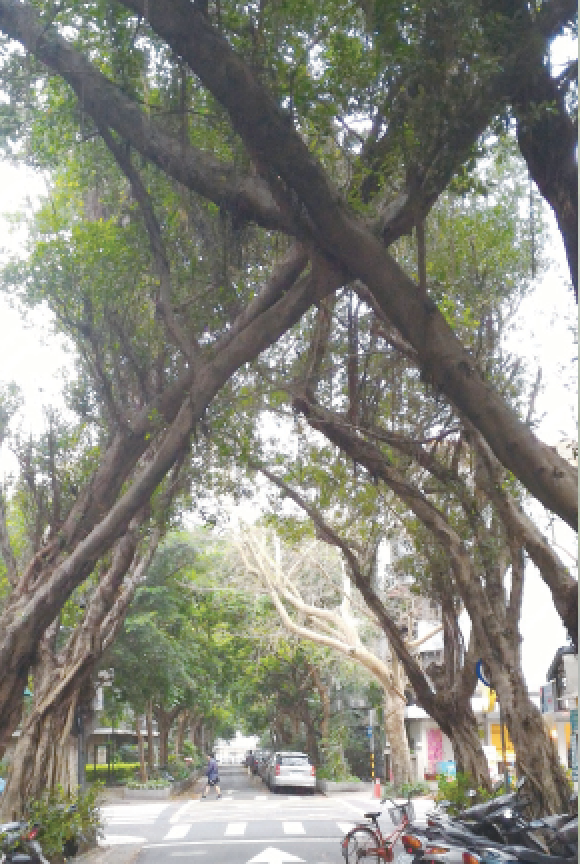

Native to Taiwan, the banyan trees or marabutan are the city trees of Taipei. In addition, the novella “The Old Capital” and our interviewees mentioned the following roles that the trees play:
- Memories of Schools
- Residents over the Roofs and Walls
- Witnesses of the Changes
Photo Credit: Biodiversity of Taipei by Taipei City Animal Protection Office
Page 111. Back then, before commercial real estate had led to an unrestrained opening of new roads, a building boom, and land speculation, trees could survive and grow tall and green, like those in tropical rain forests.
页 160. 那时候的树,也因土地尚未商品化,没大肆开路竞建炒地皮,而得以存活得特别高大特别绿,像赤道雨林的国家。
[/et_pb_vertical_timeline_item] [/et_pb_vertical_timeline]
Banyan are native trees, but they have decreased in number in Taipei because they can grow over a huge area but in the city “an inch of land is an ounce of gold.”
Memories of Schools
Page 121-122. did you run over to dig beneath a banyan tree after school…the banyan fruit, no matter how pretty it looked, was wormy, When you opened it, you had to carefully lick the wormless part with the tip of your tongue for the sweetness.
页 140/169. 一下课就跑到榕树下凭灵感择一空地挖掘…那看来再美丽饱满的榕树子拨开都有虫,你只得用舌尖小心舔舔它无虫部位的甜味。
[/et_pb_vertical_timeline_item][et_pb_vertical_timeline_item title=”Stop 2. Near junior high school…” use_read_more=”off” animation=”off” text_font_select=”default” text_font=”||||” headings_font_select=”default” headings_font=”||||” use_border_color=”off” border_style=”solid”]
Page 198. most commonly seen near junior high school campuses (unless the buildings were old, then yes, there would be banyans, Chinese gum trees in the north, and flame trees in the south, and trees with a South Seas flavor, which you knew by heart–betel palms, mallows, and coconuts).
页 193/231. 最显见的是大量的国中校舍周遭(除非使用的校舍是以老校舍权充,那就是、对、榕树、北部枫、南部凤凰、和南国の风情的你也会背了的槟榔、蒲葵、大王椰)。
[/et_pb_vertical_timeline_item] [/et_pb_vertical_timeline]
Banyan trees are our memories of schools.
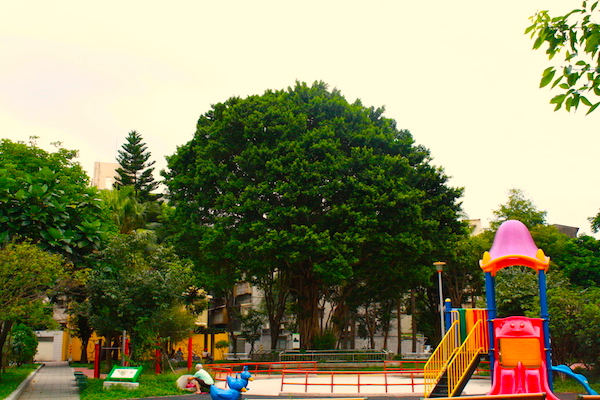
Photo Credit: Leah Suffern
In Front of a Temple
Besides schools, the banyan trees also are found in front of temples. Under the trees the courtyard is cool, seats are casually arranged, shows are staged to entertain both the deities and the mortals:
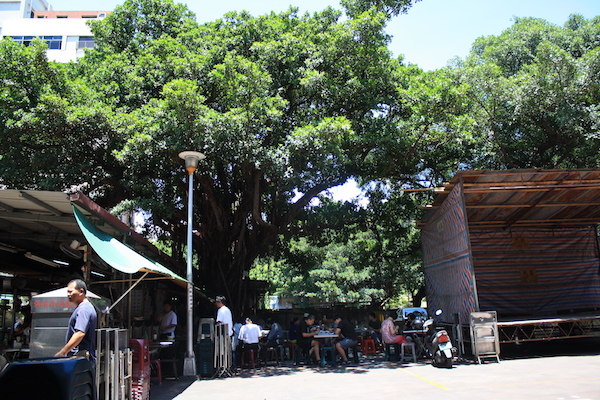
Photo Credit: Leah Suffern
Residents over the Roofs and Walls
Page 153. on Changchun Road, sparrow banyan trees spilled over the fence of No. 249…Then there was the place kitty-corner from No. 18, Lane 63 of Linqi Street, where a paper mulberry, a banyan, and a breadfruit tree formed a triangle.
页 162/195. 长春路二四九号,雀榕趴在墙头…此外尚有临沂街六三巷十八号斜对门,构树、榕、面包树三国鼎立。
[/et_pb_vertical_timeline_item][et_pb_vertical_timeline_item title=”Stop 4. Whose seeds can sprout anywhere…” use_read_more=”off” animation=”off” text_font_select=”default” text_font=”||||” headings_font_select=”default” headings_font=”||||” use_border_color=”off” border_style=”solid”]
Pages 155-156. such as Nos. 7 and 9 in Lane 91, Section 2 of Ren’ai Road; No. 4 in Lane 62, Section 2 of Ji’nan Road; and No. 71, Alley 1, Lane 24, Section 3 of Ren’ai Road. The owners even set down strict rules about trees; they planted only cherries, arhat pines, and South Pacific firs, while preventing the growth of a variety of mulberries and sparrow banyans, whose seeds can sprout anywhere and thrive once they are dropped by birds.
页 164/197. 如仁爱路二段九一巷七号和九号、济南路二段六二巷四号、仁爱路三段二四巷一弄七一号,他们甚至连植物都严格护持住,只种植樱和罗汉松和南洋杉,不让鸟儿们四处播种的雀榕和大小叶桑衍生。
[/et_pb_vertical_timeline_item][et_pb_vertical_timeline_item title=”Stop 5. Obscuring the tiled roofs and stone walls…” use_read_more=”off” animation=”off” text_font_select=”default” text_font=”||||” headings_font_select=”default” headings_font=”||||” use_border_color=”off” border_style=”solid”]
Page 193. Nogi-machi…a big house that was all but engulfed by banyan and sweet gum trees…trees in the yard grew wild (the original owners had mostly planted trees with, yes, a South Seas flavor–coconut, betel palm, mango, banyan), obscuring the tiled roofs and stone walls, thus avoiding attention.
页 189-190/228. 乃木町。被榕树和枫香掩盖的大户人家…只任凭庭园树种肆意怒长(通常是原住者植的南国风情的、对、椰子槟榔芒果榕树⋯⋯)好遮掩住炼瓦屋顶和石屏墙,免遭人注意。
[/et_pb_vertical_timeline_item][et_pb_vertical_timeline_item title=”Stop 6. Spreading out from the cracks…” use_read_more=”off” animation=”off” text_font_select=”default” text_font=”||||” headings_font_select=”default” headings_font=”||||” use_border_color=”off” border_style=”solid”]
Pages 211-212. No. 321 was in total ruin, completely absorbed by demonic kidney ferns and ficus…Xinjiyi, at No. 88, across the street, had Corinthian columns with acanthas leaves on the second floor, but its resplendent baroque flavor was not enough to keep its owners around; the new owner was the vibrant sparrow banyan spreading out from the cracks in the walls.
页 202/242. 三二一号大废,被成了精怪的肾蕨雀榕牢牢吸附住…对门的八八号新集益是二楼的列柱头有外卷的叶片状的柯林斯式,华丽的巴洛克风味留不住人,屋主是墙缝里生意盎然的雀榕。
[/et_pb_vertical_timeline_item] [/et_pb_vertical_timeline]
Over the Wall
There is a Japanese-style dormitory district between National Taiwan University and National Taiwan Normal University. Many of them were mentioned in Chu T’ien-hsin’s novella “The Old Capital” but no longer existed. Some, like what we see in this photo, were hid among the aerial roots of banyan trees. The banyan on the left of the photo even stretches its roots, much thicker than human arms, onto the wall and into the wall’s cracks, as if telling a story that has been buried underground.
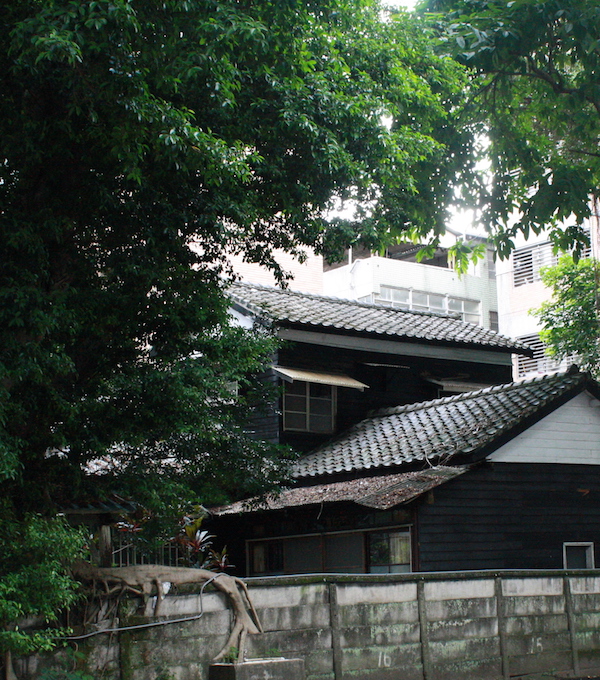
Photo Credit: Leah Suffern
Over the Roofs
We like how the novella puts it: The banyan trees are the “owners” of many houses and shops:
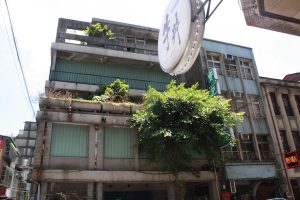

Photo Credit: Leah Suffern
Witnesses of the Changes
Page 159. you were pacing outside the bleak amusement park of your childhood, not sure whether to go in or not, when you spotted a stone stele covered in intertwining banyan roots, climbing figs, and sedge.
页 166/200. 你正徘徊在萧条的旧日儿童乐园前决定不了进不进园,倒发现榕须、薜荔、纱草夹缠下有一石碑。
[/et_pb_vertical_timeline_item][et_pb_vertical_timeline_item title=”Stop 8. Your secret garden…” use_read_more=”off” animation=”off” text_font_select=”default” text_font=”||||” headings_font_select=”default” headings_font=”||||” use_border_color=”off” border_style=”solid”]
Page 173. Until that year you took the person you were going to marry to visit your secret garden. Just as before, you followed familiar paths and walked beneath the big banyan tree by Mackay Hospital.
页 176/212. 一直到某一年,你带着确定要结婚的丈夫拜访你的秘密花园。如同往常一样,熟门熟路迳穿过偕医馆旁的大榕树下。
[/et_pb_vertical_timeline_item][et_pb_vertical_timeline_item title=”Stop 9. Banyan Gardens…” use_read_more=”off” animation=”off” text_font_select=”default” text_font=”||||” headings_font_select=”default” headings_font=”||||” use_border_color=”off” border_style=”solid”]
Page 205-206. he invited the two of you to Banyan Gardens, where you ordered a bottle of beer and a plate of stir-fried little shellfish, and talked about the national shame of the nearby Dutch garrison, called the Red Hair building, until you choked on our own words…It was so cold outside that you were the only person sitting beneath the tall banyan tree. The wooden floor at your feet was raised above the river, like the Kamo-gawa cooling bed in the summer.
页 198/237-238. 请你们去榕园喊瓶啤酒炒盘蚋仔,讲不远处的红毛城国耻直到哽咽难言…天气仍很冷,只你一人做在室外的大榕树下,脚下的木头地板架空于河面,好像夏天鸭川畔的纳凉床。
[/et_pb_vertical_timeline_item][et_pb_vertical_timeline_item title=”Stop 10. Under which were a basketball court…” use_read_more=”off” animation=”off” text_font_select=”default” text_font=”||||” headings_font_select=”default” headings_font=”||||” use_border_color=”off” border_style=”solid”]
Page 215. Chinese hibiscuses and banyan trees, under which were a basketball court on the east side and a skating rink on the west; they hadn’t decided what to do with the place.
页 203-204/244. 黄槿榕树之属,树荫下未有决心的东一处球场西一块溜冰场。
[/et_pb_vertical_timeline_item] [/et_pb_vertical_timeline]
By the Church
We visited the church mentioned in the novella, but we did not find (or pay attention to) any banyan trees there. Instead, we took photos of the banyan tree by another church on the GuiDe Street. Its giant canopy and draping aerial roots, as well as the way it spilled over the fence bars astonished us:
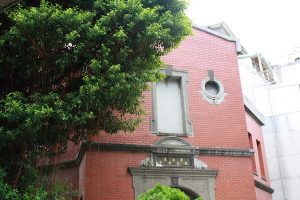

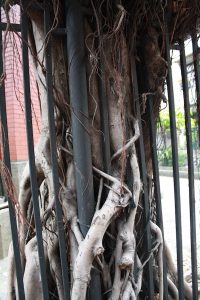
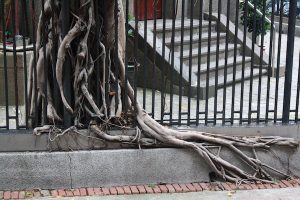
Photo Credit: Leah Suffern
What trees witness the changes of the city? I would say the banyan trees on the bank of the Tamsui River.
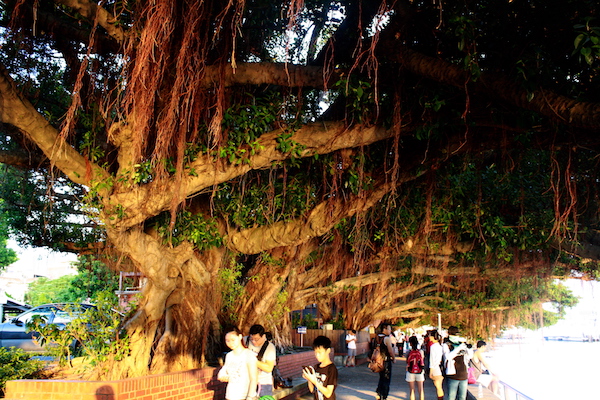
Photo Credit: Leah Suffern

0 Comments